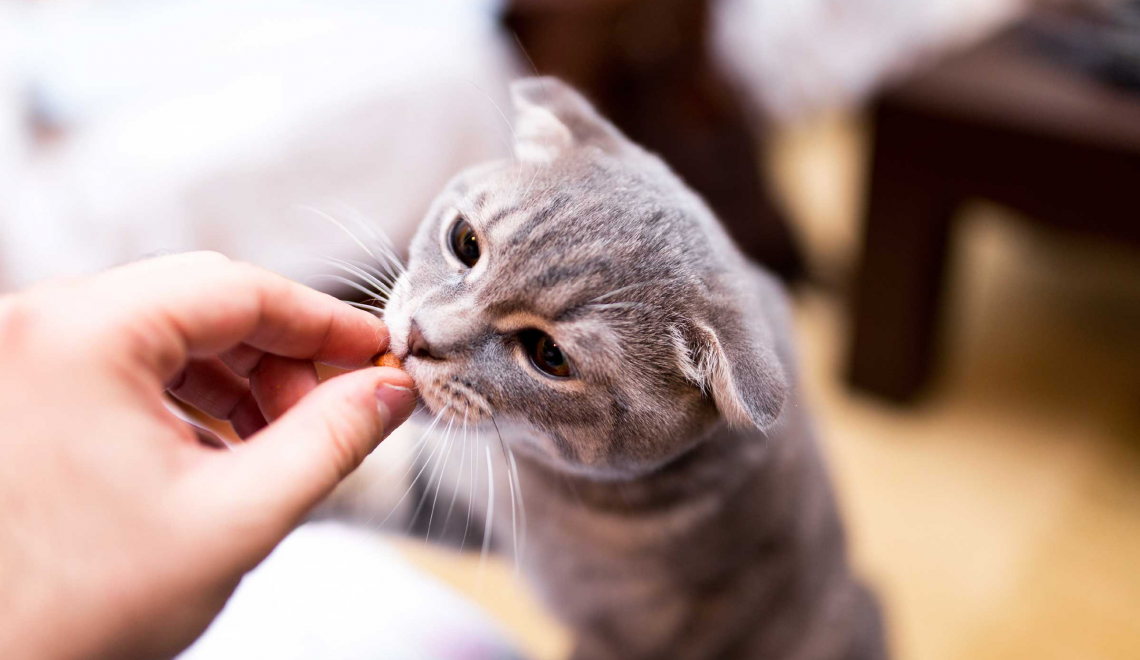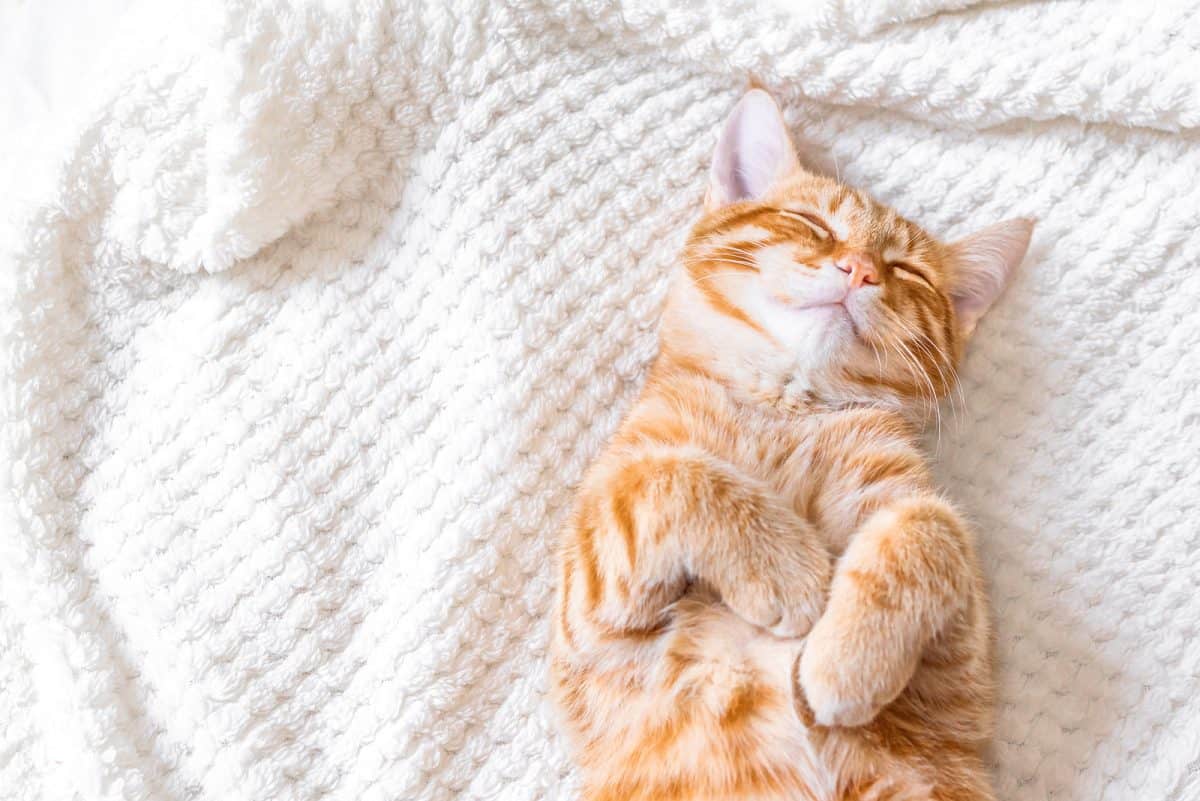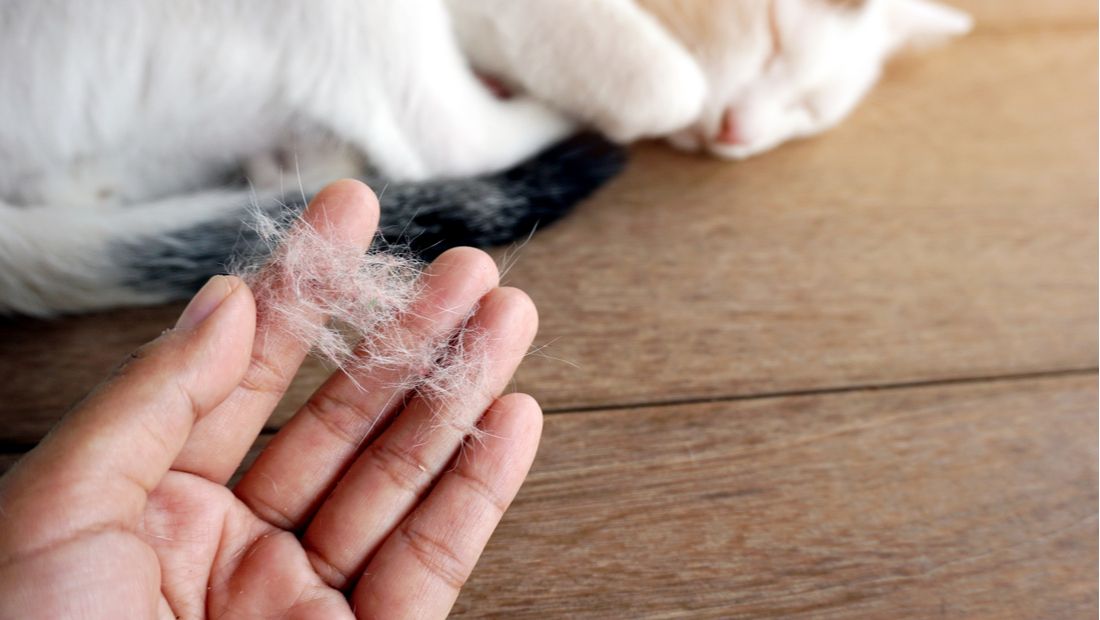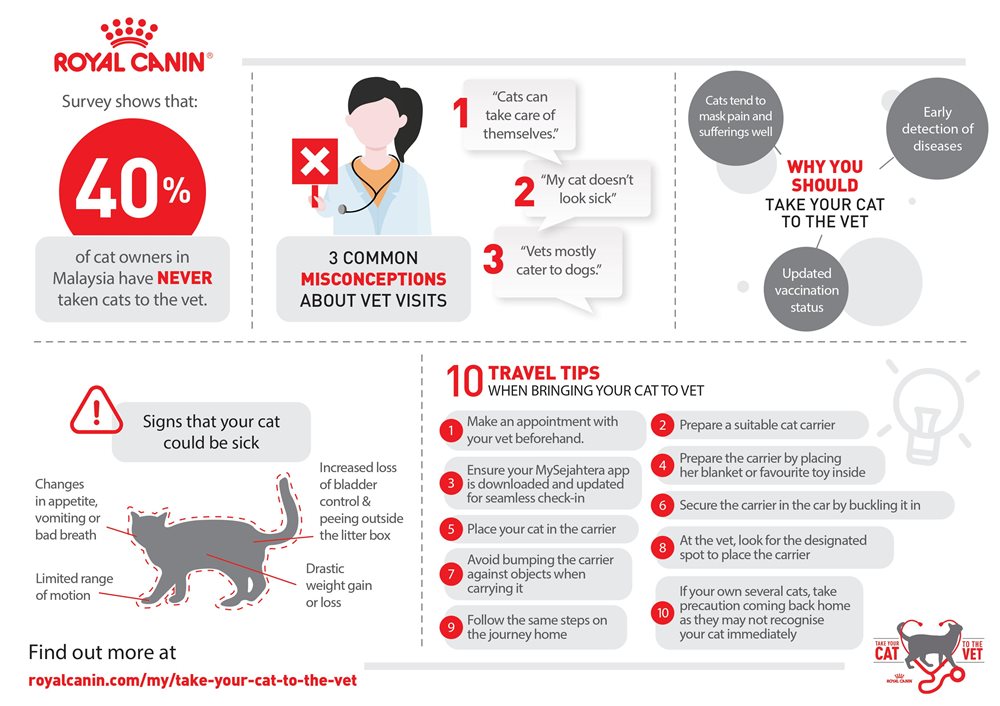Cats are the joy of the world and have been the unofficial overlord of the world for centuries dating back to ancient Egyptian times.
Numerous studies have shown that having a cat will help reduce stress, although it does feel like we’re slaving away everyday catering to their own needs.
And sometimes, your cat might behave or act in a way that got you thinking, “Is this normal? Should I be worried?”

We recently spoke to Dr Dylan Choy, Scientific Communication Manager at Royal Canin Malaysia and a registered veterinarian about our furry feline’s behaviour, and we even asked her some questions submitted by our lovely readers and fellow cat parents.
So, if you want to know why your kitty kat is behaving a certain way, read on:
Each cat has his/her own personality like humans as well, while some are more sociable, some may prefer to be left alone. Some of the telltale signs include hiding at a corner or in a box, or constantly trying to move away from a crowd. Cat owners should know their cats’ personalities best, and to provide them the most comfortable environment for them, be it at home or outside.
This could probably be due to the cat’s personality or one’s previous experience, no matter pleasant or otherwise. It’s quite common for some adopted cats to show less affinity towards being carried or touched, especially if the cat has experienced unpleasant scenarios relating to being touched or carried prior to that.
However, if there is a sudden change in behaviour, like for example, cats getting aggressive when being touched or carried while they are usually fine with such interactions, it’s best to take your cat to the vet as they may be exhibiting signs of pain and discomfort.
Cat owners should always refer to the recommended feeding guidelines that are usually printed on the pack itself. Generally, cats are ‘snackers’, which means they actually eat 10-16 small meals in a day! Do ensure that the total amount of food fed in a day to your cats are still within the recommended feeding amount to avoid overfeeding.
Sometimes when your cat is in a certain posture during sleep, snoring can also happen, especially if slight pressure is applied along the airways. While it is normal for some cats to occasionally snore, snoring can also be a sign of diseases, such as presence of growths or even foreign objects along the respiratory airway. This is especially true if other signs such as lethargy, reduced appetite or even nasal discharges accompany the snoring. Get your cat checked by a registered veterinarian if there are such concerns.


Periuria, or the condition whereby cats urinate outside the litter box/tray, can be a symptom of urinary tract disorder. It can also be a sign of distress, which often happens when there is a change in the living environment of the cat.
If you are living in a multi-cat household (i.e. if you own more than one cat), it is best for you to provide more litter tray for your cats. The rule of thumb for the number of litter trays to prepare is the amount of cats you have plus another one tray. You should also ensure that these litter trays are cleaned regularly too.
Cats, especially indoor cats can spend up to 16 hours a day sleeping. Cats are crepuscular, which is a zoological term for animals that are active in twilight (between dusk and dawn). This may be a reason why cats are often seen to be sleeping in the noon and early evenings, and waking you up in wee hours in the night or early mornings. Just like the wild cats, your cat adheres to this schedule of hunting, feasting and sleeping closely.
In cases where the cat owners are unsure whether or not the mating process took place, a cat in early pregnancy phase will show signs of noticeable weight gain, swelling of the nipples (about week three of pregnancy), and distended abdomen (by around week five of pregnancy).
You may also notice that your cat has increased appetite in the early stages of pregnancy, which reduces towards the end of pregnancy, when they are about to give birth. It is highly advisable for you as a cat owner to bring your pregnant cat to the vet to monitor the kittens’ growth rate and to get an estimated date of birth.


Kittens usually have their 26 deciduous teeth (or commonly known as ‘milk teeth’) replaced with the 30 adult teeth by the age of 5-6 months old. Between the ages of 3.5 months to 4 months of age, you may start noticing that some of the ‘milk teeth’ may have fallen out – and that is absolutely normal.
It is normal for a cat to shed their fur slightly more than usual about one to two times in a year. This process is known as ‘moulting’, whereby the old fur coat is being replaced by new fur coat. Regular grooming of your cat is also very important to ensure a thick, healthy fur coat, especially for your longhaired cats.
However, if your cat is excessively shedding despite regular grooming and there are other signs accompanying this, e.g. itching, flaking of the skin, presence of uneven shedding (‘bald patches’), reddening of the skin etc., these could be an indication of skin issues which require your veterinarian’s attention.
Neutering your cat can also bring about many health benefits – and numerous studies have shown that neutered cats are generally healthier and they also live longer compared to unneutered cats.
It is highly dependent on your cat’s lifestyle – whether they are kept indoor or outdoor. Generally indoor cats can have longer interval between baths, simply because they are less exposed to dirt and other materials. A simple rule of thumb is to bathe your cat whenever they are visibly soiled. Otherwise, once every month is a good interval for most cats.
We hope that these answers will help you solve some of the greatest mysterious surrounding your cat! If you are unsure or see signs that indicate that your furry friend needs medical attention, immediately bring him or her to see a registered vet.
A lot of cat parents in Malaysia don’t know the importance of bringing their beloved pet to the vet so this year, Royal Canin Malaysia has organised a ‘Take Your Cat To The Vet’ campaign to create awareness and emphasise the importance of regular check-ups for cats.

Cat parents are encouraged to bring their felines to a registered vet at least twice a year to not only help prevent diseases but for early detection or diagnosis of health issues, reducing the impact of disease, and more efficacious treatment.
For more info, visit Royal Canin Malaysia’s Facebook page.
Numerous studies have shown that having a cat will help reduce stress, although it does feel like we’re slaving away everyday catering to their own needs.
And sometimes, your cat might behave or act in a way that got you thinking, “Is this normal? Should I be worried?”

We recently spoke to Dr Dylan Choy, Scientific Communication Manager at Royal Canin Malaysia and a registered veterinarian about our furry feline’s behaviour, and we even asked her some questions submitted by our lovely readers and fellow cat parents.
So, if you want to know why your kitty kat is behaving a certain way, read on:
1. Do cats ever feel awkward or embarrassed like humans do?

Each cat has his/her own personality like humans as well, while some are more sociable, some may prefer to be left alone. Some of the telltale signs include hiding at a corner or in a box, or constantly trying to move away from a crowd. Cat owners should know their cats’ personalities best, and to provide them the most comfortable environment for them, be it at home or outside.
2. Why do some cats hate being touched or carried?

This could probably be due to the cat’s personality or one’s previous experience, no matter pleasant or otherwise. It’s quite common for some adopted cats to show less affinity towards being carried or touched, especially if the cat has experienced unpleasant scenarios relating to being touched or carried prior to that.
However, if there is a sudden change in behaviour, like for example, cats getting aggressive when being touched or carried while they are usually fine with such interactions, it’s best to take your cat to the vet as they may be exhibiting signs of pain and discomfort.
3. How much should I feed my cat and how many times per day?

Cat owners should always refer to the recommended feeding guidelines that are usually printed on the pack itself. Generally, cats are ‘snackers’, which means they actually eat 10-16 small meals in a day! Do ensure that the total amount of food fed in a day to your cats are still within the recommended feeding amount to avoid overfeeding.
4. Is it normal for cats to snore while sleeping?
Some brachycephalic cats (i.e. cats with flat face structure, such as Persians) are more prone to snoring as they have shortened bones in their face and nose. Some of them even have elongated soft palates that can cause partial blockage to the entrance of air to the windpipe – which can give rise to strange noises when your cat is sleeping.Sometimes when your cat is in a certain posture during sleep, snoring can also happen, especially if slight pressure is applied along the airways. While it is normal for some cats to occasionally snore, snoring can also be a sign of diseases, such as presence of growths or even foreign objects along the respiratory airway. This is especially true if other signs such as lethargy, reduced appetite or even nasal discharges accompany the snoring. Get your cat checked by a registered veterinarian if there are such concerns.
5. When should I bring my cat to the vet? And how frequent should I go?
Cats should be brought to the vet for check-up at least twice a year.6. How do I know if my cat is terminally ill? What symptoms should I look out for?
Symptoms or signs related to terminal illnesses can vary greatly as different conditions can bring about various symptoms. For example, Stage 4 chronic kidney disease patients can exhibit cachexia (severe loss of muscle mass), vomiting, diarrhea or even seizure. Therefore, it is very important to bring your cats for vet visits often to prevent late diagnosis of diseases.
7. Is it okay to feed my cat treats everyday?
While it may be alright for you to feed treats to your cat daily, it is important to ensure that you are feeding them less than 10 per cent of their daily caloric requirement from treats. You should also be selective of the types of treats you feed your cats with and know the recommended amount and frequency to be fed.8. My cat started to pee everywhere but not in its litter box, which it usually doesn’t do. Why is this happening?

Periuria, or the condition whereby cats urinate outside the litter box/tray, can be a symptom of urinary tract disorder. It can also be a sign of distress, which often happens when there is a change in the living environment of the cat.
If you are living in a multi-cat household (i.e. if you own more than one cat), it is best for you to provide more litter tray for your cats. The rule of thumb for the number of litter trays to prepare is the amount of cats you have plus another one tray. You should also ensure that these litter trays are cleaned regularly too.
9. Why do cats sleep so much?

Cats, especially indoor cats can spend up to 16 hours a day sleeping. Cats are crepuscular, which is a zoological term for animals that are active in twilight (between dusk and dawn). This may be a reason why cats are often seen to be sleeping in the noon and early evenings, and waking you up in wee hours in the night or early mornings. Just like the wild cats, your cat adheres to this schedule of hunting, feasting and sleeping closely.
10. How do I know if my cat is pregnant?

In cases where the cat owners are unsure whether or not the mating process took place, a cat in early pregnancy phase will show signs of noticeable weight gain, swelling of the nipples (about week three of pregnancy), and distended abdomen (by around week five of pregnancy).
You may also notice that your cat has increased appetite in the early stages of pregnancy, which reduces towards the end of pregnancy, when they are about to give birth. It is highly advisable for you as a cat owner to bring your pregnant cat to the vet to monitor the kittens’ growth rate and to get an estimated date of birth.

11. Do cat’s teeth fall out? If so, what is the normal age it should happen and should I be worried if it happens too early?

Kittens usually have their 26 deciduous teeth (or commonly known as ‘milk teeth’) replaced with the 30 adult teeth by the age of 5-6 months old. Between the ages of 3.5 months to 4 months of age, you may start noticing that some of the ‘milk teeth’ may have fallen out – and that is absolutely normal.
12. My cat’s fur is shedding like crazy, why? What should I do to make its fur thick and healthy?

It is normal for a cat to shed their fur slightly more than usual about one to two times in a year. This process is known as ‘moulting’, whereby the old fur coat is being replaced by new fur coat. Regular grooming of your cat is also very important to ensure a thick, healthy fur coat, especially for your longhaired cats.
However, if your cat is excessively shedding despite regular grooming and there are other signs accompanying this, e.g. itching, flaking of the skin, presence of uneven shedding (‘bald patches’), reddening of the skin etc., these could be an indication of skin issues which require your veterinarian’s attention.
13. Is it important to spay and neuter your cats?
Yes, it is especially if you are not planning to breed your cats, especially those that are allowed to roam around the neighbourhood, as not doing so may contribute to unplanned pregnancy and litters that leads to overpopulation issue.Neutering your cat can also bring about many health benefits – and numerous studies have shown that neutered cats are generally healthier and they also live longer compared to unneutered cats.
14. How often do we have to bathe our cats?

It is highly dependent on your cat’s lifestyle – whether they are kept indoor or outdoor. Generally indoor cats can have longer interval between baths, simply because they are less exposed to dirt and other materials. A simple rule of thumb is to bathe your cat whenever they are visibly soiled. Otherwise, once every month is a good interval for most cats.
We hope that these answers will help you solve some of the greatest mysterious surrounding your cat! If you are unsure or see signs that indicate that your furry friend needs medical attention, immediately bring him or her to see a registered vet.
A lot of cat parents in Malaysia don’t know the importance of bringing their beloved pet to the vet so this year, Royal Canin Malaysia has organised a ‘Take Your Cat To The Vet’ campaign to create awareness and emphasise the importance of regular check-ups for cats.

Cat parents are encouraged to bring their felines to a registered vet at least twice a year to not only help prevent diseases but for early detection or diagnosis of health issues, reducing the impact of disease, and more efficacious treatment.
For more info, visit Royal Canin Malaysia’s Facebook page.







